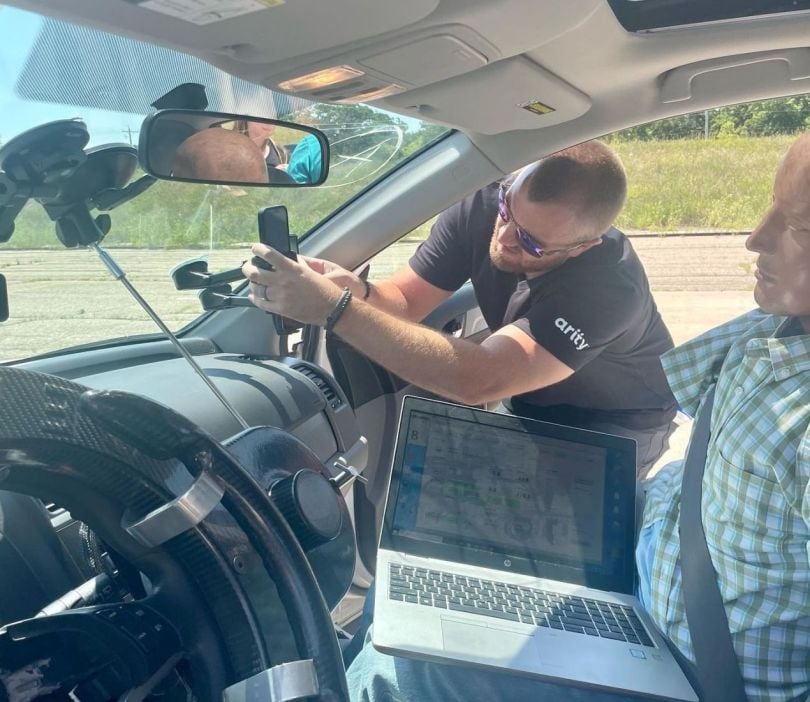When a car crash occurs, every second matters.
That’s why Arity, a company that creates data-driven solutions for organizations in the transportation space, continuously tests and refines its crash detection algorithm. Validating the accuracy of the algorithm is all part of the company’s mission to make transportation safer for everyone.
The technology enables mobile apps to detect accidents in real time by taking signals from a person’s phone and other devices and applying proprietary algorithms to determine whether a crash has occurred. This helps those involved in a crash receive the help they need when they need it the most.
Refining the algorithm offers its fair share of exciting, complex challenges for Lucas Antony, a data scientist who works on the company’s core telematics team. For example, some activities, such as riding a roller coaster or a dirt bike, may send signals that seem like a crash, and it’s up to him and his teammates to determine whether a life-threatening event has actually occurred.
“In general, the data we get to work on is interesting and involves thinking about things through a physics lens at times while keeping in mind advances in smartphone hardware and software,” Antony said.
To ensure the algorithm functions effectively, Antony and his peers collaborate closely with other teams, including product. Group Product Manager Lauren Krieberg explained that a significant amount of cross-functional technical design work goes into ensuring the solution brings a high level of accuracy to the market. Her team also works to navigate the complexities of a new advanced operating model for both iOS and Android.
Director of Mobile Engineering Pankaj Verma believes the complexity of the operating model creation is partly due to the evolutionary nature of the mobile ecosystem.
“Building frameworks on top of ever-evolving platforms, such as Apple’s iOS and Google’s Android, is never an easy task,” he explained.
This intricacy, though simply one element of the development process, reflects the universal doggedness and mission-driven passion that fuels team members’ efforts to continuously improve the crash detection algorithm. By relying on each other and their teams, Antony, Krieberg and Verma successfully overcome various technical hurdles to potentially save millions of lives.
SUPPORT IN EVERY SENSE
Arity’s crash detection algorithm is impactful in the sense that it contacts emergency services when an individual is involved in a car crash, but its impact goes beyond that. According to Krieberg, insurance users and providers can make the claims process easier by using additional data from an accident, while local departments of transportation can use the solution to see where crashes are commonly occurring and make necessary infrastructure changes to make roads safer. “Working on a product like crash detection is personally rewarding because it offers the rare opportunity to have a tangible, positive effect on people’s lives and safety,” she said.
Nothing Stands in The Way of Safety
When it comes to deploying a new operating model at Arity, the risks are real — real-world, that is.
“We don’t want to accidentally push a change that has a negative effect on anyone’s safety,” Krieberg explained.
Krieberg and her teammates work together to improve Arity’s deployment technology, balancing the desire to regularly deploy improved models while also ensuring the model will perform effectively. With support from the company, the team accesses the tools they need to remotely deploy new models to partners’ apps without requiring an app update, meaning users receive the latest version of the solution as soon as possible.
Krieberg and her peers give consumers the safest, most updated version of the crash detection algorithm, and collaboration is a core ingredient for that success. This teamwork remains intact as they maintain the technology’s robustness, both internally and externally. When Krieberg and her peers aren’t relying on each other to continuously improve the algorithm, they’re teaming up directly with customers to ensure the technology is producing the right level of impact.
“I regularly talk to our customers to make sure we continue to meet expectations for the operating model as well as the many features and integrations surrounding the crash detection algorithm,” she said.
“I regularly talk to our customers to make sure we continue to meet expectations for the operating model as well as the many features and integrations surrounding the crash detection algorithm.”
While Krieberg’s team offers technical support from a product perspective, Antony and his teammates work to solidify the technology’s performance. They work with the engineering team to ensure the technology is incorporated properly and they adjust to anything that isn’t working with their designs.
“This process requires a knowledge transfer on how it should operate while providing the necessary material to test that the code works as expected for both developers and quality-assurance testers,” Antony said.
Although the development and continuous refinement of Arity’s crash detection algorithm has been a success overall, the road hasn’t been easy to tread. A recent obstacle Antony and his teammates encountered was misalignment in testing the new algorithm on the iOS version.
“A lot of time was spent going back and forth with daily checkpoints between myself and the software developers to debug it and change things, until we finally found the very subtle difference between implementations that were causing tests to fail,” he recalled.
But by digging into solutions together, Antony and his colleagues successfully maintain and continuously improve a truly innovative, influential solution – one that exists on millions of mobile devices.
TEST, THEN TEST AGAIN
Imagine a van running with hundreds of mobile devices every single day. According to Arity, this isn’t simply an idea — it’s one of the ways in which the company tests its products in the real world, as this type of experiment produces enough driving data for his team to leverage to continuously improve their technology. He added that the company also hides its beta features behind remotely configured feature flags, which allows him and his peers to test their solutions with a targeted set of end users and then plan ahead with known facts rather than theories.
But the testing doesn’t stop there. Krieberg noted that the company also conducts controlled car crashes, working with its partners to gather data from these crashes. “I’ve been able to view some of those crash tests in person, and it has been really valuable to see the destruction of what can happen in different scenarios and how we should alter what we do to accommodate each scenario,” she said.

Staying Ahead of The Curve
While collaboration and technical expertise are key drivers behind Arity’s crash detection algorithm, there is another major element fueling team members’ efforts: an innovative culture.
Antony said the culture fosters experimentation and risk-taking, and it encourages team members to constantly test out new ideas that will benefit customers. During the first Friday of each month, employees take part in “Learn Day,” where they get to listen to their peers give presentations on work-related topics or personal passions.
Evidence of the culture of experimentation can be found in Antony’s breakthrough idea that he was given free rein to research and explore during slow periods — an idea that would ultimately impact the crash detection algorithm.
“No major expectations were set, but I had time to just see what would happen if I experimented,” Antony recalled. “Ultimately, one of those models was chosen to go into production.”
Being a technologist at Arity is all about taking the initiative and driving continuous progress, whether that involves spearheading a project or leveraging a new technology. Antony added that team members are expected to be able to pivot and readily pick up new tools, as well as find creative ways to work more efficiently. It’s also important to be a team player who can embrace different approaches to a problem.
“You need to be able to handle cross-functional work and communicate well with those who have different backgrounds and perspectives than yours,” he said.
Working effectively with others is key, and according to Krieberg, this collaboration is made easier by the intelligence and dedication of those who work across the company’s tech teams.
“Arity is a great fit for anyone who wants to solve complex problems and regularly enjoys learning new things alongside people who are motivated to constantly improve,” she said.
“Arity is a great fit for anyone who wants to solve complex problems and regularly enjoys learning new things.”
There’s a lot that goes into the organization’s technological endeavors, from working with actual sensors inside Apple and Android devices to exploring new technologies linked to machine learning. Verma believes this eagerness to stay ahead of the curve and be bold are just a few of the hallmarks that define the company’s technologists.
For him, working alongside talented people who challenge him to grow isn’t the greatest aspect of being a team member at Arity — it’s the company’s impact that motivates him the most every day.
“Knowing that a feature like crash detection actually saves lives makes me feel proud, keeps me excited and encourages me to be better,” Verma said.








